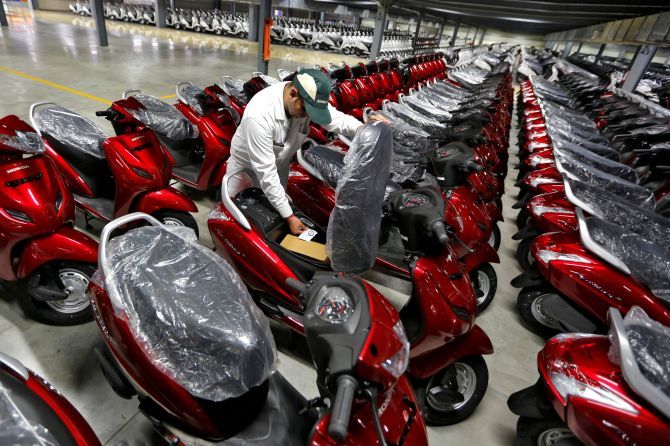The auto index has borne the brunt of the market decline, becoming the biggest loser among sectoral indices over the last month.

It was also among the top losers (down over 4 per cent) on Monday, wherein stocks of most automobile makers declined between 4 per cent and 6.5 per cent.
The BSE Auto index has declined around 16 per cent in the past month, which is about twice the losses incurred by the benchmark BSE Sensex.
The sharp rally in commodity prices due to the Russian invasion of Ukraine and its impact on margins, higher cost of ownership, muted volumes and supply shortages are the key triggers for the decline in auto stocks.
What has hit sentiment further is a draft proposal by the government to increase vehicle insurance premiums for financial year 2022-23 (FY23).
Third-party motor insurance premiums have not been increased over the last two years and if this is approved, insurance costs for specific segments could rise by a fifth.
The worst impacted is the 350cc and above two-wheeler segment, where premiums are up 21 per cent.
Royal Enfield (Eicher Motor) is the market leader in the segment.
The premiums in the 150-350cc two-wheeler category are also being increased by 15 per cent and this could impact Bajaj Auto the most.
The sharp rise in commodity costs will weigh on margins and increase the running costs for consumers.
Elara Securities highlights that overall operating profit margins for the sector in the December quarter were down 390 basis points (bps) year-on-year (YoY) and 90 bps on a sequential basis led by commodity, container costs and negative operating leverage due to production cuts by automakers.
These worries have been amplified because of the surge in the commodity basket.
While steel prices have gained up to 12 per cent, aluminium prices are up over 17 per cent over the past month.
Rishi Vora of Kotak Institutional Equities highlights that aluminium and palladium spot prices have increased 40-55 per cent from Q3 levels.
Aluminium and precious metal content forms around 10 per cent of passenger vehicle market leader Maruti Suzuki’s average selling prices.
“The company will find it challenging to completely pass on the raw material impact to consumers as it may derail demand recovery, especially in entry-level segments,” he adds.
The demand for utility vehicles and higher end two-wheelers is better than for entry-level vehicles, the shortage of semiconductors is playing spoilsport.
The situation could turn more challenging. Says Tim Uy of Moody’s Analytics, “If a deal is not brokered in the coming months, expect the chip shortage to get worse and for industries highly dependent on them to be similarly affected. This means significant risks are ahead for many automakers.”
Tata Motors, Mahindra & Mahindra, Eicher Motors, and Bajaj Auto could face more impact as would auto component makers both in India and in key markets abroad like Europe, China, and the US.
Most auto segments will get hit, but Mitul Shah, head of research, Institutional Equities at Reliance Securities, believes commercial vehicle (CV) companies, tyre makers and two-wheeler makers would see the maximum earnings cuts for FY22/23 due to higher raw material prices and limited ability to pass on cost inflation amid low volumes.
Some of the worries are getting reflected in the stock of pure play CV maker Ashok Leyland, which is the top loser among auto stocks over the past month, having declined 27 per cent.
The Street will watch out for the impact of the multiple headwinds on the CV segment, which was witnessing a recovery due to a pickup in economic activity and improving fleet operator profitability.
Within the two-wheeler space, brokerages prefer exporters such as Bajaj Auto and TVS Motor to Hero MotoCorp.












 © 2025
© 2025